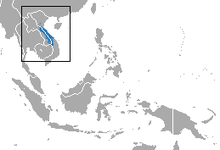Red-legged clothes monkey
| Red-legged clothes monkey | ||||||||||||
|---|---|---|---|---|---|---|---|---|---|---|---|---|

Red-legged robe monkey ( Pygathrix nemaeus ) |
||||||||||||
| Systematics | ||||||||||||
|
||||||||||||
| Scientific name | ||||||||||||
| Pygathrix nemaeus | ||||||||||||
| ( Linnaeus , 1771) |
The red-legged robed monkey ( Pygathrix nemaeus ) is a species of primate from the group of the slim monkeys (Presbytini). The gray- legged and black-legged clothes monkey , which used to be considered subspecies of the red-legged clothes monkey, are now considered to be separate species. This primate species lives in Southeast Asia and its population is threatened.
features
Redshank robe monkeys are extremely colorful primates. The back and the top of the head are gray, the thighs black and the lower thighs are surrounded by the red-brown "stockings" that give it its name. The upper arms are gray, the forearms whitish, hands and feet are black. The tail and the base of the tail are white. The coloring of the genital organs is also noticeable, the penis is bright red and the scrotum white. On the face, the orange-colored region around the eyes and the white hair on the pelvis are noticeable. These primates reach a head body length of 61 to 76 centimeters, the tail becomes as long as the body. With an average weight of 11 kilograms, males are slightly heavier than females who reach 8 kilograms.
distribution and habitat
Red-legged robed monkeys live in northern and central Vietnam as well as in the neighboring regions of Laos . Presumably there was also a population on the Chinese island of Hainan , but this is likely to have died out. The habitat of these animals are forests, both primary and secondary forests .
Lifestyle and diet
Like all Old World monkeys, these primates are diurnal and live almost exclusively in trees. They are skilled climbers and create regular trails through the branches for better progress. They live in groups of up to 50 animals that are either mixed groups (several males and females) or harem groups (one male and several females); mixed groups are likely to predominate.
They are herbivores that feed primarily on young leaves. They also eat fruits, seeds and flowers. The sharing of found food among the group members should occur relatively frequently. Like all slim monkeys, they have a multi-chambered stomach , which enables a better breakdown of the difficult to digest leaf food.
Reproduction
Mating is preceded by a mating ritual, which includes, among other things, both sexes playing grimaces. After a gestation period of around six months, the female usually gives birth to a single young. At first it clings to the mother's stomach, later the other group members also take care of it. Clothes monkeys are sexually mature at around four years of age.
Threat and Safeguards
The main threat is the progressive loss of habitat through deforestation. The populations were also severely decimated by the bombings and the use of defoliants in the Vietnam War . The World Conservation Union IUCN lists the Rotschenkligen clothes monkeys in the Red List of Threatened Species as endangered ( Endangered ).
In the meantime, some nature reserves have been established and projects are ongoing to ensure the continued existence of the species. As a result of its listing in the Washington Convention on CITES, Appendix I, the species is subject to an international trade ban like all species of the genus. At the European level, this status is adopted and laid down in the EU Species Protection Regulation (EC) No. 338/97 and EC Regulation 407/2009 Appendix A, whereby all member states of the European Union are obliged at the same time.
literature
- Thomas Geissmann : Comparative Primatology. Springer-Verlag, Berlin a. a. 2003, ISBN 3-540-43645-6 .
Web links
- UNEP-WCMC Species Database. Retrieved March 15, 2010 (English, query Pygathrix nemaeus ).
- Information on Theprimata.com
- Pictures, videos and information at arkive.org
Individual evidence
- ↑ Pygathrix nemaeus in the endangered Red List species the IUCN 2010. Posted by: Ngoc Thanh, V., Lippold, L., Timmins, RJ & Manh Ha, N., 2008. Accessed on March 15 of 2010.
- ^ The CITES Appendices. CITES Convention on International Trade in Endangered Species of Wild Fauna and Flora, May 22, 2009, accessed on March 15, 2010 (English, The Appendixes of the Washington Convention, CITES).

